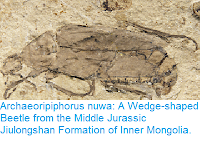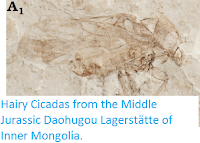Froghoppers, Cercopoidea are small members of the True Bug order
(Hemiptera), related to Cicadas, Cicadoidea, Leafhoppers and
Treehoppers, Membracoidea. They resemble Leafhoppers, but are smaller
and more robust. Over 3000 species of Froghoppers have been described to
date, they are found throughout the world and most numerous in the
tropics, although tropical Froghoppers have not been extensively studied
to date. Modern Froghoppers are divided into five families, the Cercopidae, Aphrophoridae, Clastopteridae, Machaerotidae, and Epipygidae, with another three, extinct, families represented in the Mesozoic fossil record, the Procercopidae, Sinoalidae, and Cercopionidae. The Procercopidae are the oldest of these groups, first appearing in the fossil record in the Early Jurassic in Eurasia and Australia, and persisting at least until the Early Cretaceous.
In a paper published in the journal Palaeoentomology on 28 December 2018, Yanzhe Fu of the State Key Laboratory of Palaeobiology and Stratigraphy at the Nanjing Institute of Geology and Palaeontology, and the University of Science and Technology of China, Diying Huang, also of the State Key Laboratory of Palaeobiology and Stratigraphy at the Nanjing Institute of Geology and Palaeontology, and Michael Engel of the Division of Entomology at the Natural History Museum of the University of Kansas, and the Department of Ecology and Evolutionary Biology at the University of Kansas, describe a new species of Procercopid Froghopper from the Middle Jurassic Haifanggou Formation, part of the Daohugou Lagerstätte of Inner Mongolia.
The Haifanggou Formation outcrops around Daohugou Village, and has
produced a large number of exceptionally well preserved Insects, which
along with similar fossils from the associated Jiulongshan Formation
form
what is commonly known as the Daohugou Lagerstätte, part of the Yanliao
Biota. The fossils are thought to be late Middle Jurassic in origin,
from the boundary between the Bathonian and Callovian eras, making them
about 165 million years old. This provides a valuable insight into
insect diversity in the Jurassic, before the appearance and rapid rise
to dominance of Angiosperms (Flowering Plants), an event which radically
reshaped Insect faunas. The Daohugou beds are interpreted as a lake environment, with
largely still waters.
The new species is placed in the genus long-lived genus Anthoscytina, which currently contains eleven species from the Early Jurassic to Early Cretaceous of northern Asia, and given the specific name 'daidaleos', meaning 'spotted' or 'dappled' in reference to the pattern on the hind wings. The species is described from four female specimens and a fifth of indeterminate sex, ranging in length from 12.6 to 13.5 mm, and differentiated from other members of the genus by the pattern of veins in the wings (commonly used as a way to differentiate Insect species).
Specimen of Anthoscytina daidaleos from the Middle to Upper Jurassic Haifanggou Formation
at Daohugou. Scale Bar is 2 mm. Fu et al. (2019).
at Daohugou. Scale Bar is 2 mm. Fu et al. (2019).
See also...
Follow Sciency Thoughts on Facebook.







